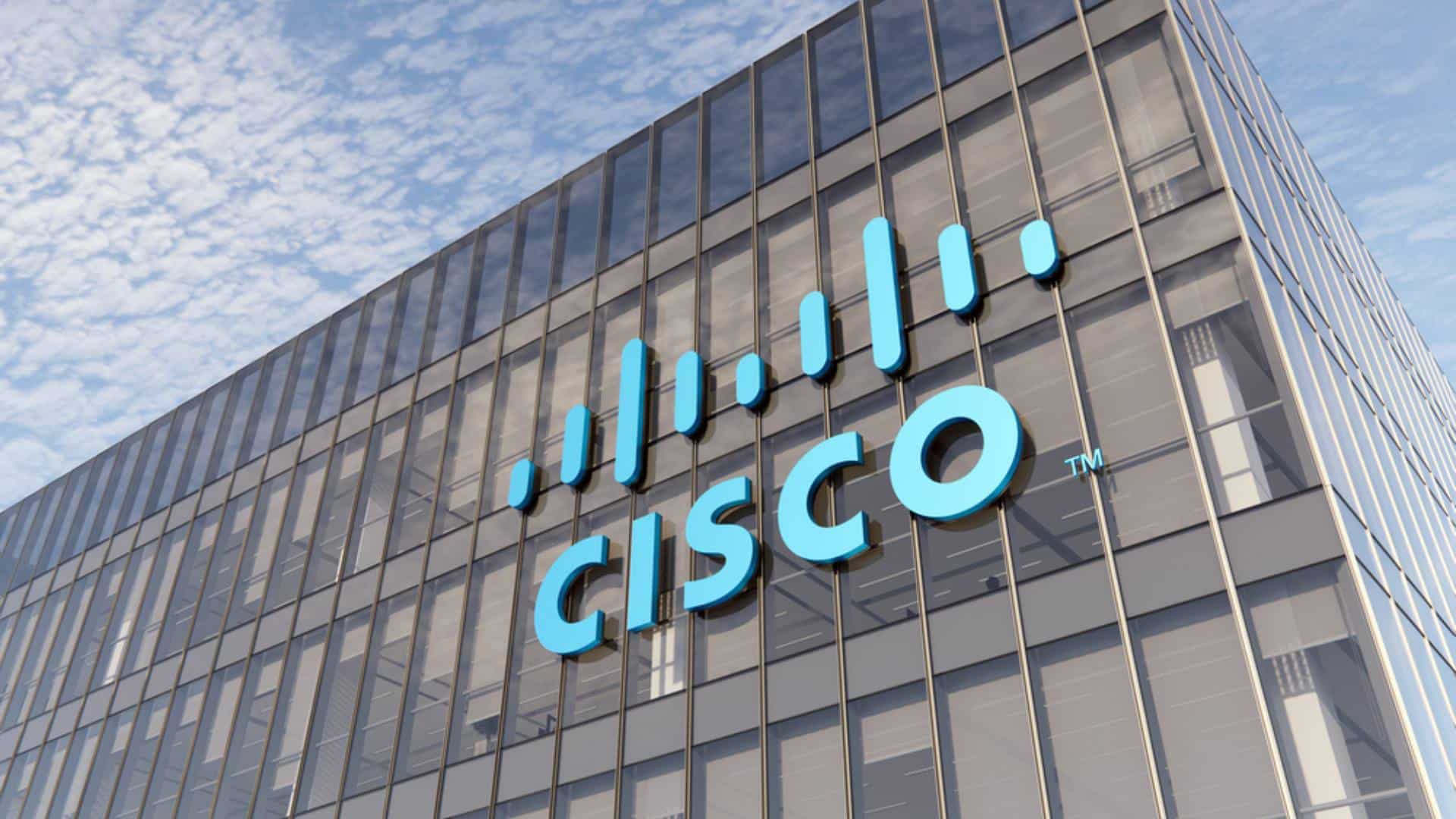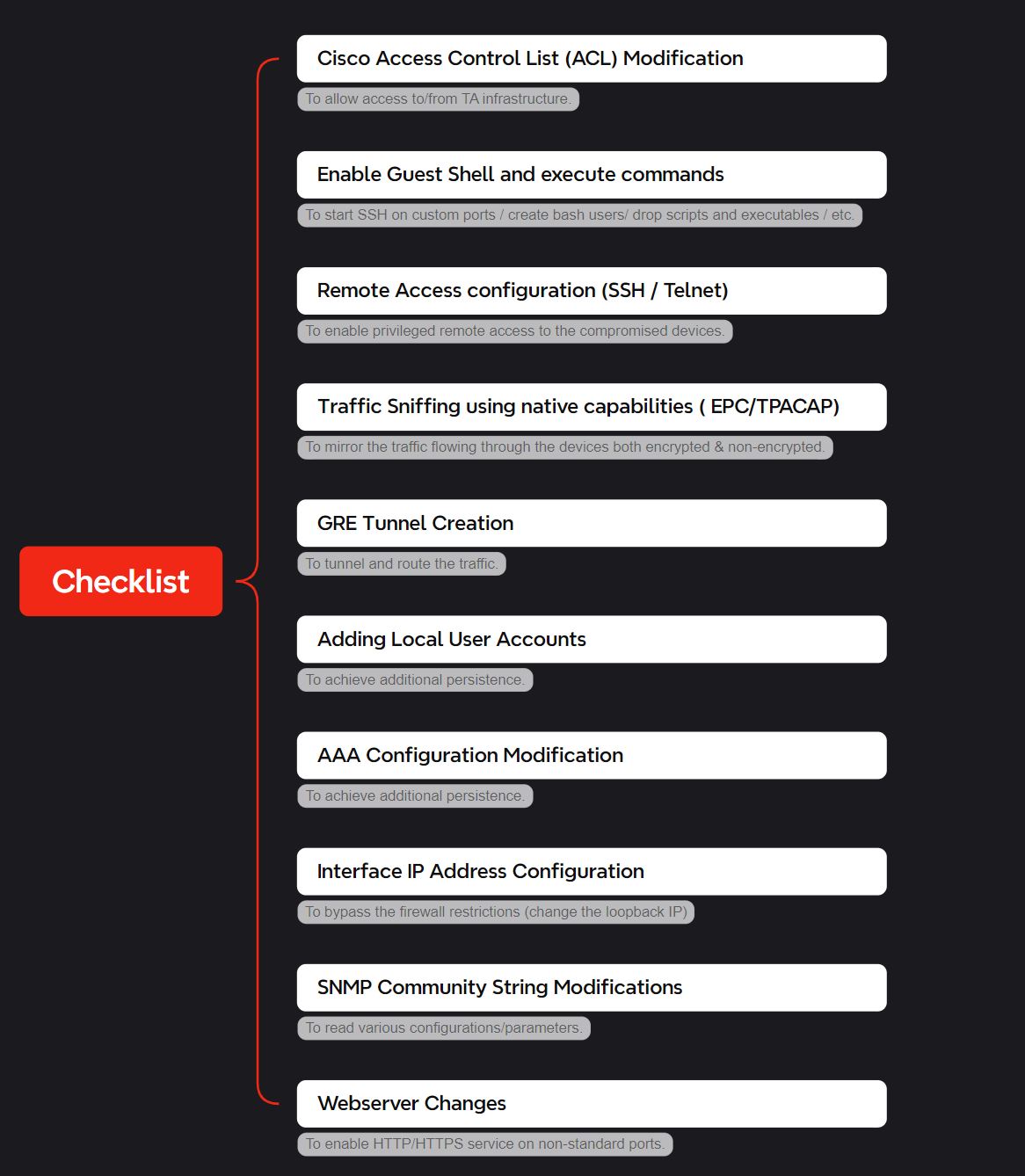Investigating compromised CISCO Routers and Switches
Historically, attackers targeted network devices for DoS, but now they exploit these devices like any other endpoints
Initial access: Owning a router / switch device allows attackers to access data flows & launch further attacks on the infrastructure. This can be either by exploiting the vulnerabilities or by using valid credentials; however, in most cases, it was the stolen credentials that played out.
Dumping the Config: It’s quite common in breaches for the threat actor to exfiltrate the device configuration in order to understand the network segments, access controls, NAT, identity configurations, and passwords for login, SNMP, etc.
Lateral movement: Moving from one compromised device to another within the network is a common approach. If the compromised organization is a telecommunications company or ISP, then the threat actor may go after the call records for the unencrypted calls.
Investigation Playbook
✨This checklist can be handy when you’re investigating a Cisco network device for any compromises. It helps you understand how a threat actor might exploit the native capabilities for their advantage.
The
Guest Shellis a lightweight Linux container in Cisco IOS XE (not standard IOS) that allows users to run bash shell, scripts, or tools directly on the device.
Evidence of traffic sniffing.
Network devices like routers and switches are perfect targets for sneaking out data since the data flow through them, whether it’s encrypted or not. Cisco devices have features like Tpacap or Embedded Packet Capture (EPC), which attackers often use to quietly monitor the traffic without messing with the network device.
You can check the device history or logs to see if attacker enabled and used features like EPC. Since these devices can run for years, like 2-3 years without rebooting, it’s a good idea to check their memory by grabbing the core dump.
The command history for all commands entered through vty interfaces is stored in an internal buffer, and this command history buffer is included in core dump file generated. We can review the core dump to identify commands. Below is a similar command found in the Cisco core dump when the attacker tried to enable sniffing.
1
2
3
4
5
6
7
8
coredumps/router-dxb_coredump.bin:monitor capture buffer%s%s%d
coredumps/router-dxb_coredump.bin:monitor capture pointassociate%s%s
coredumps/router-dxb_coredump.bin:monitor capture buffer%sfilter%sCapturepoint%sdoesnotexist
coredumps/router-dxb_coredump.bin:monitor capture pointipv6cef%sall%s
coredumps/router-dxb_coredump.bin:monitor capture pointipv6cef%spunt
coredumps/router-dxb_coredump.bin:monitor capture pointipv6cef%sdrop
coredumps/router-dxb_coredump.bin:monitor capture pointipv6cef%s%s%s
coredumps/router-dxb_coredump.bin:monitor capture pointipv6process-switched%sfrom-us
Cisco IOS Integrity Verification
Persistence is quite challenging on network devices compared to servers and endpoints. In most cases, attackers rely on memory-related tactics, techniques, and procedures (TTPs) or by adding privileged users to the appliance.
Another way attackers ensure persistence is by loading and running a backdoored IOS. By installing this malicious IOS, the threat actor makes sure there is always a persistence, even after rebooting the devices.
When investigating Cisco network devices, it’s important to verify the integrity of the IOS running on the appliance. Cisco provides a few options to verify the authenticity of the IOS running in the memory and stored on the flash. Here are some of the checks I normally do to make sure the running IOS version is genuine. You can follow a Cisco link here, which provides more detailed checks.
You can use these methods to identify modifications to Cisco IOS image files and run-time memory.
There are mainly three types of hash values it provides when running the command: Computed Hash, Embedded Hash, and CCO Hash.
1
verify flash0:c2900-universalk9-mz.SPA.151-43.M3.bin
In simple terms, the Embedded Hash is something Cisco computes and stores during the image build process. This can be used to verify the integrity of the IOS file, but not the IOS running in memory.
The Computed Hash is something calculated when we issue the above command for the running IOS image. This value should be the same as the Embedded Hash; otherwise, the image may have been altered for backdoors.
Finally CCO Hash, on the other hand, is the hash of the whole image file. This can be shared with Cisco support to validate the integrity of the IOS.
1
2
3
4
5
6
7
8
9
10
11
12
Computed Hash SHA2: 8785156FB7B6DFC8FE0F08AC21AA8974
9ARE428A7BA83D19A14ABAC5C342B228
T789147163636DC5AB10CD3DDC4C2345
ABAE6B01105F5356C9F115156F26106A
Embedded Hash SHA2: 8785156FB7B6DFC8FE0F08AC21AA8974
9ARE428A7BA83D19A14ABAC5C342B228
T789147163636DC5AB10CD3DDC4C2345
ABAE6B01105F5356C9F115156F26106A
CCO Hash MD5 : AB4BD5287A236586ABD146F58E353456
Digital signature successfully verified in file flash0:c2900-universalk9-mz.SPA.151-43.M3.bin
Another feature Cisco provides is to verify integrity using the below commands; there are two methods: one to check the file stored on the appliance, and the other to check the running IOS.
1
show software authenticity file flash0:c2900-universalk9-mz.SPA.151-43.M3.bin
here is the output
1
2
3
4
5
6
7
8
9
10
File Name : flash0:c2900-universalk9-mz.SPA.151-43.M3.bin
Image type : Production
Signer Information
Common Name : CiscoSystems
Organization Unit : C2900
Organization Name : CiscoSystems
Certificate Serial Number : 3F693684
Hash Algorithm : SHA512
Signature Algorithm : 2048-bit RSA
Key Version : A
And the below is for what is currently running on the device.
1
show software authenticity running
here is the output
1
2
3
4
5
6
7
8
9
10
11
12
13
14
15
16
SYSTEM IMAGE
------------
Image type : Production
Signer Information
Common Name : CiscoSystems
Organization Unit : C2900
Organization Name : CiscoSystems
Certificate Serial Number : 3F693684
Hash Algorithm : SHA512
Signature Algorithm : 2048-bit RSA
Key Version : A
Verifier Information
Verifier Name : ROMMON 1
Verifier Version : System Bootstrap, Version 15.0(1r)M15, RELEASE SOFTWARE (fc1)
Technical Support: http://www.cisco.com/techsupport
Side Notes
Below are some basic tools I have used against the Cisco core dump, which were quite effective in identifying attacker behaviors in some of the cases I handled.
1
2
3
4
5
6
7
bulk_extractor -o out core_dump.bin
bulk_extractor -o out -x all -e net core_dump.bin # extarct pcap file
strings core_dump.bin | grep -E "\b([0-9]{1,3}\.){3}[0-9]{1,3}\b" > ips.txt
grep -R -a -F "monitor capture" coredumps/ > monitor.txt
If a threat actor gets their hands on compromised credentials for Cisco devices, typical security features like safe coding libraries, ASLR, digitally signed software, and Cisco Secure Boot won’t really help.
If you’re dealing with an incident involving Cisco network devices, definitely check out the Cisco documentation and scripts. Trust me, they’ll be a huge help.

